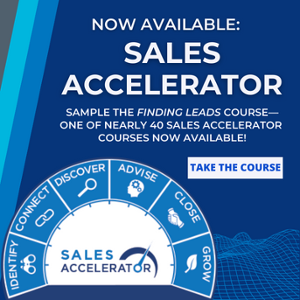
Routines, schedules, processes—they all make us more efficient, consistent, and accurate in our roles. A strong sales process helps the prospect along their journey but also acts as a roadmap for reps so that they can consistently close deals.
The strategic sales process that we teach at The Center for Sales Strategy is called Sales Accelerator. It's an updated look at the customer-focused sales process, addressing how the sales process has evolved, and more in-step with how real selling is done today.
There are six steps of the Sales Accelerator, each filled with several courses that goes deep enough to build an effective, tailored solution while moving fast enough to achieve acceleration. Sales managers take note; these are the things you don’t want your team to overlook in the first step—Identify—of the sales process.
 A Proven Strategic Sales Process
A Proven Strategic Sales Process
The Sales Accelerator Process helps:
- Salespeople identify the best accounts
- Connect with them quickly
- Discover their desired business results
- And advise them on a solution that delivers measurable results
Sellers are taught how to remove surprises to speed up the sale, and then how to deliver on promises to grow the business. The process helps sellers build effective, tailored solutions while moving fast enough to achieve acceleration.
First Step of the Sales Process: Identify
HubSpot data finds that more than 40% of salespeople say prospecting is the most challenging part of the sales process, followed by closing (36%) and qualifying (22%).
Identify is also known in other sales systems as “Prospect,” “Select,” or “Find.” They all share the same goal of selecting high potential accounts. Some other areas the Identify courses cover are determining the best categories to target, and ways to find and qualify your leads.
Overlooked Sales Prospecting Techniques
Sales is a step-by-step process, and the first step is most crucial. “As salespeople, time is one of your most valuable assets,” states Senior Coach, Alysa Hinshaw. “Ensure they take the time to truly qualify a prospect to make sure they have dollar potential, access to the decision maker, and can benefit from the solutions they have to sell. This can spare them a lot of headaches and save a tremendous amount of time in the long run.”
While it’s tempting to fill your sales pipeline with potential prospects, remember, Identify, is focused on selecting high potential accounts. It sounds so simple, but rather than going after the hard to convince prospects, focus the categories and prospects that need your product or service. You want your salespeople to use the Target Business Profile to do this, and they’ll learn about that in the Identify step.
Researching your high value targets in order to develop a customized messaging strategy can dramatically improve your prospecting effectiveness. However, often new sellers can get stuck in this phase and they spend all their time getting ready to get ready. Dean Moothart, Director of Client Solutions says this is often due to call reluctance. “Don’t let account research get in the way of actually making calls. Strike a balance. Putting your research into practice will help you refine your messaging from one prospect to the next and your effectiveness will improve over time.”
The benefits of having a sales process extend far beyond your company’s bottom line. The Sales Accelerator sales process works because it’s intuitive and it addresses real problems and offers tailored solutions.
Stay tuned as we continue our Coaching the Sales Process series and gather tips from our experts on things you don’t want your salespeople to overlook when going through the Sales Accelerator sales process.

